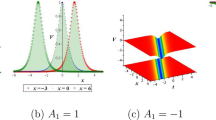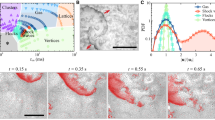Abstract
We investigated the effect of source condensate and temperature dependence structure ramification on particle excretion from the dynamic aspects of the sources with numerical analysis of quantum supremacy. The dynamics interpretation of a system that can travel along stable states can become exceedingly complex and interferometry is an efficient tool that probed the superlative of these complicated dynamical properties. This research presents a brief analysis of convoluted systems in the context of quantum interference for partially chaotic sources. The eminence of coherence structure on chaotic production has been demonstrated using correlation plots and the normalized chaotic parameter for quasi-granular systems that account for a significant portion of chaos fluxes has also been investigated with computational techniques. In the existence of the quantum influence, the model computations explore the systems structure that extends across an oscillation track with temperature and momentum fluctuations. Tables exhibit the quantitative data of chaotic and coherent source droplets exhibiting stochastic features and present a premise that depicts motivated conversions between cold and hot particles which are initiated by a continuously time-dependent crossover during the expanding of emitted sources. To examine the characteristics of the particles expelled by convoluted systems, we formulate the normalized chaos interception for the hybrid systems to assess the tunability of the source structure for medical and engineering applications.








Similar content being viewed by others
Data Availability Statement
The authors confirm that the data of this research are available within the manuscript. This manuscript has associated data in a data repository. [Authors’ comment: The generated and analyzed data during this research are included in this published manuscript.]
References
E.N. Lorenz, Deterministic nonperiodic flow. J. Atmos. Sci. 20, 130–141 (1963)
M. Gyulassy, S.K. Kauffmann, L.W. Wilson, Pion interferometry of nuclear collisions. 1. Theory Phys. Rev. C 20, 2267 (1979)
U.A. Wiedemann, U.W. Heinz, Particle interferometry for relativistic heavy ion collisions. Phys. Rept. 319, 145 (1999)
M.M. Aggarwal et al., One, two and three particle distributions from 158-A-GeV/c central Pb + Pb collisions. Phys. Rev. C 67, 014906 (2003)
D. Gangadharan, Techniques for multiboson interferometry. Phys. Rev. C 92, 014902 (2015)
T. Lappi, A. Dumitru, Y. Nara, Structure of chromomagnetic fields in the glasma. Nucl. Phys. A 931, 354–358 (2014)
L. McLerran, From the Glasma to the QCD phase boundary. Acta Phys. Polon. Supp. 10, 663 (2017)
W. Ketterle, Experimental studies of Bose–Einstein condensation. Phys. Today 52, 30–35 (1999)
G. Bary, P. Ru, W.N. Zhang, Analyses of multi-pion Hanbury Brown–Twiss correlations for the pion-emitting sources with Bose–Einstein condensation. J. Phys. G 45(6), 065102 (2018)
T. Csorgo, Particle interferometry from 40-MeV to 40-TeV. Acta Phys. Hung. A 15, 1–80 (2002)
B.L. Friman, K. Kajantie, P.V. Ruuskanen, Converting mixed phase into hadrons. Nucl. Phys. B 266, 468–486 (1986)
M. Gyulassy, K. Kajantie, L.D. McLerran, Deflagrations and detonations as a mechanism of hadron bubble growth in supercooled quark gluon plasma. Nucl. Phys. B 237, 477–501 (1984)
D. Seibert, Analysis of scaled factorial moment data. Phys. Rev. D 41, 3381 (1990)
B.B. Abelev et al., Two- and three-pion quantum statistics correlations in Pb–Pb collisions at \(\sqrt{{s}_{NN}} =\) 2.76 TeV at the CERN Large Hadron Collider. Phys. Rev. C 89, 024911 (2014)
J. Adam, et al., Multipion Bose–Einstein correlations in pp,p -Pb, and Pb–Pb collisions at energies available at the CERN Large Hadron Collider. Phys. Rev. C 93, 054908 (2016)
U.W. Heinz, Q.H. Zhang, What can we learn from three pion interferometry? Phys. Rev. C (1997). https://doi.org/10.1103/PhysRevC.56.426
U. Ornik, M. Plumer, D. Strottmann, Bose condensation through resonance decay. Phys. Lett. B 314, 401 (1993)
J.P. Blaizot, F. Gelis, J.F. Liao, Bose–Einstein condensation and thermalization of the quark gluon plasma. Nucl. Phys. A 873, 68–80 (2012)
J.P. Blaizot, F. Gelis, J. Liao, Thermalization and Bose–Einstein condensation in overpopulated glasma. Nucl. Phys. A 904–905, 829c–832c (2013)
E. Ikonen, Chaoticity parameter lamda and multiple coherent components in relativistic heavy-ion collisions. Phys. Rev. C 78, 019903 (2008)
G. Goldhaber, S. Goldhaber, W.Y. Lee, A. Pais, Influence of Bose–Einstein statistics on the anti-proton proton annihilation process. Phys. Rev. 120, 300 (1960)
G. Bary et al., Quantum statistical perspective to examine the source chaos fraction through boson femtoscopy. Fractals 30, 2240186 (2022)
H. Boggild et al., Three pion correlations in sulphur lead collisions at the CERN SPS. Phys. Lett. B 455, 77 (1999)
J. Adams et al., Three pion HBT correlations in relativistic heavy ion collisions from the STAR experiment. Phys. Rev. Lett. 91, 262301 (2003)
R. Willson, Measurement of source chaoticity for particle emission in Au+Au collisions at \(\sqrt{s_{NN}}\) =130 GeV using three particle HBT correlations. Nucl. Phys. A 715, 619 (2003)
S. Pratt, P.J. Siemens, A.P. Vischer, Kaon pictures of QCD plasma droplets. Phys. Rev. Lett. 68, 1109 (1992)
F. Dalfovo, S. Giorgini, L.P. Pitaevskii, Theory of Bose–Einstein condensation in trapped gases. Rev. Mod. Phys. 71, 463 (1999)
W.N. Zhang, Y.M. Liu, L. Huo, Detection of source granularity through multiparticle Bose correlations. Phys. Rev. C 51, 922 (1995)
G. Bary, W.N. Zhang, P. Ru, J. Yang, Analyses of multi-pion Bose-Einstein correlations for granular sources with coherent pion-emission droplet. Chin. Phys. C 45, 024106 (2021)
W.N. Zhang, Z.T. Yang, Y.Y. Ren, Characteristic quantities of pion-emitting sources extracted by model-independent analysis in relativistic heavy ion collisions. Phys. Rev. C 80, 105075 (2009)
R. Ahmad, A. Farooqi, G. Bary, A new fractional-order stability analysis of sir model for the transmission of Buruli disease: a biomedical application. Fractals 30, 2240171 (2022)
W.N. Zhang, M.J. Efaaf, C.Y. Wong, Pion interferometry for a granular source of quark-gluon plasma droplets. Phys. Rev. C 70, 024903 (2004)
G. Bary, M. Imran, M. Arslan, Regio-and stereoselective functionalization of alkenes with emphasis on mechanistic insight and sustainability concerns. J. Saudi Chem. Soc. 20, 101260 (2021)
R. Ahmad, F. Rashida, An analytical approach to study the blood flow over a nonlinear tapering Stenosed artery in flow of Carreau fluid model. Complexity (2021). https://doi.org/10.1155/2021/9921642
Y. Karaca, C. Carlo, Model estimation with SVM kernel types for cognitive diagnostics. Adv. Math. Models Appl. 4, 5–14 (2019)
G. Bary, L. Ghani, M.I. Jamil, Designing small organic non-fullerene acceptor molecules with diflorobenzene or quinoline core and dithiophene donor moiety through density functional theory. Sci. Rep. 11, 1–11 (2021)
Acknowledgements
We would like to thank Prof. Wei-Ning Zhang for invigorating discussions about the intrinsic peculiarities of the partially coherent particles emitting sources and chaotic-coherent fractions. We are also thankful to the Faculty of Science, Yibin University, Yibin, China, for the support provided for this research.
Funding
No external funding was received for this work of any type.
Author information
Authors and Affiliations
Contributions
GB was involved in conceptualization, data analysis, methodology, administration and writing of original draft; WA and RA helped in resources and writing.
Corresponding author
Ethics declarations
Competing of interests
We declare no competing interests.
Rights and permissions
Springer Nature or its licensor (e.g. a society or other partner) holds exclusive rights to this article under a publishing agreement with the author(s) or other rightsholder(s); author self-archiving of the accepted manuscript version of this article is solely governed by the terms of such publishing agreement and applicable law.
About this article
Cite this article
Bary, G., Ahmed, W. & Ahmad, R. A novel methodology in chaotification and coherence-based scientific applications under the influence of condensation. Eur. Phys. J. Plus 138, 771 (2023). https://doi.org/10.1140/epjp/s13360-023-04310-9
Received:
Accepted:
Published:
DOI: https://doi.org/10.1140/epjp/s13360-023-04310-9




